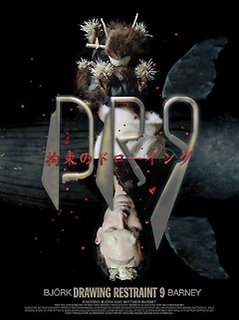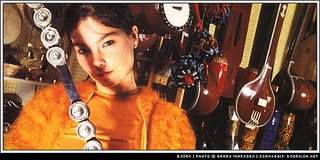DRAWING RESTRAINT 9: The NY Times VS The Village Voice
David Beardsley, fellow member of the Army of Bjork Yahoo group, has posted numerous reviews of DRAWING RESTRAINT 9 on the message board. These two opposing reviews, however, are well-written and offer seemingly valid reasons to either love or hate the film.

March 29, 2006
MOVIE REVIEW
'Drawing Restraint 9,' a Film Steeped in Ritual, With Whales and a Wedding
By STEPHEN HOLDEN
Near the end of Matthew Barney's visually spellbinding film "Drawing
Restraint 9," a work that might be described as his "Moby-Dick," the
voice of his co-star, Bjork, repeats a life-affirming motto in broken
musical phrases: "From the moment of commitment, nature conspires to
help you."
 Those are some of the few words heard in this stately, ritualistic film, which takes place mostly on the Nisshin Maru, a Japanese whaling ship afloat in Nagasaki Bay. The ship looms as a metaphor both for a whale and for Japan. "Drawing Restraint 9" is steeped not only in Japanese
Those are some of the few words heard in this stately, ritualistic film, which takes place mostly on the Nisshin Maru, a Japanese whaling ship afloat in Nagasaki Bay. The ship looms as a metaphor both for a whale and for Japan. "Drawing Restraint 9" is steeped not only in Japaneseseafaring lore but also in centuries-old Japanese ritual, which is compared in the film's earliest scenes with more frivolous examples of
contemporary pageantry.
Frivolous or not, all human activity in the film is informed by a ceremonial formality, and no task is undertaken casually.
A good part of the film follows Mr. Barney and Bjork, who are welcomed aboard the ship as Occidental guests and undergo elaborate preparations for a traditional Shinto wedding ceremony. Their union, however ecstatic, quickly leads to a solemn, stylized Liebestod that embodies the film's depiction of life as a series of passages in a relentless cycle of creation and destruction.
These scenes infuse "Drawing Restraint 9" with an overt spiritual

dimension that is a new element in Mr. Barney's work. If that
spirituality is an outgrowth of his relationship with Bjork, it is a
welcome addition in an oeuvre whose obsession with athleticism,
competition and fertility rites has sometimes taken on fascistic
overtones. Bjork's chant encapsulates the film's call for human beings
to recognize, revere and surrender to the principle of change.
Like Mr. Barney's "Cremaster Cycle," "Drawing Restraint 9" is a
cinematic component of a larger exhibition, opening at the San Francisco
Museum of Modern Art on June 23, that will embrace videos, sculptures,
drawings and photographs. The complexities of such a multimedia work
will perhaps be best scrutinized by art critics and historians. But the
theatrical release of "Drawing Restraint 9" as a feature film now
invites its contemplation as a stand-alone movie. And as a mostly
nonverbal series of interconnected images with a soundtrack composed by
Bjork, "Drawing Restraint 9" represents a significant advance from "The
Cremaster Cycle." The uninitiated viewer can admire it simply for the
majesty of its visual poetry.
 Its rhythms are solemn but never static; the color glowing; the largely
Its rhythms are solemn but never static; the color glowing; the largelyambient score evocative. Even the most enigmatic images, shot from many different angles, are arresting. The camera repeatedly returns to the
deck of Nisshin Maru, where sailors in a choreographed assembly line
fill a mold with 25 tons of hot petroleum jelly that hardens to resemble a giant hunk of cheese that is later sliced. Vaseline has been a
constant (and, to my mind, witty) symbol in Mr. Barney's work.
For all the solemnity surrounding the preparation of this mutable sculpture, it lends "Drawing Restraint 9" an undertone of zany humor.
Everything that happens on deck is reflected in what happens below.
After the wedding ceremony, Mr. Barney and Bjork cling together while a
thunderstorm gathers. As the ship is tossed on the water, liquid
petroleum jelly begins to leak into their cabin. As the newlyweds, still
completely in each other's thrall, become immersed, they pull out
flensing knives and slice away pieces of each other's lower bodies,
which mutate into creatures with whale-like tails. The storm subsides,
the sculpture is reassembled, and the ship is last seen among ice floes
approaching Antarctica.
That describes just the shell of a film that acquires more layers the
more familiar you are with Mr. Barney's work. If his auspicious
collaboration with Bjork has little in common with that of John Lennon
and Yoko Ono, who met on the border of pop music and fine art, there is
one fundamental similarity.
 Bjork infuses Mr. Barney's architectural concepts with emotion in much the same way that Lennon's emotion warmed up and helped popularize Ms. Ono's abstractions.
Bjork infuses Mr. Barney's architectural concepts with emotion in much the same way that Lennon's emotion warmed up and helped popularize Ms. Ono's abstractions.Drawing Restraint 9
Opens today in Manhattan.
Written and directed by Matthew Barney; director of photography, Peter
Strietmann; music by Bjork; production designer, Matthew D. Ryle;
produced by Barbara Gladstone and Mr. Barney; released by IFC Films. At
the IFC Center, 323 Avenue of the Americas, at Third Street, Greenwich
Village. Running time: 135 minutes. This film is not rated.
WITH: Bjork and Matthew Barney.
---------------------------------------------------

Barney's Rubble
Cremasturbatory art film exercises no restraint
by Ed Halter
March 28th, 2006 1:11 PM
Drawing Restraint 9
Written and directed by Matthew Barney
IFC Films, opens March 29, IFC Center
 Those who fear that the mainstream of contemporary art has become little more than an extension of fashion will find no comfort in Drawing Restraint 9, Matthew Barney's latest big-budget ejaculation of ritual self-involvement and superficial foofery. Named as part of a series of installations and performances that stretch back to the late 1980s, this 135-minute film isn't part of the artist's over-hyped Cremaster cycle, but continues in its vein: an unsatisfying marriage of excessive production values with insipid cinematography and flat-footed editing. Showing little of its titular quality, Restraint delivers yet another plodding nonsense-rebus of esoteric symbolism with the profundity of a Bloomingdale's window display.
Those who fear that the mainstream of contemporary art has become little more than an extension of fashion will find no comfort in Drawing Restraint 9, Matthew Barney's latest big-budget ejaculation of ritual self-involvement and superficial foofery. Named as part of a series of installations and performances that stretch back to the late 1980s, this 135-minute film isn't part of the artist's over-hyped Cremaster cycle, but continues in its vein: an unsatisfying marriage of excessive production values with insipid cinematography and flat-footed editing. Showing little of its titular quality, Restraint delivers yet another plodding nonsense-rebus of esoteric symbolism with the profundity of a Bloomingdale's window display.Whereas the last Cremaster installment explored a St. Patrick's Day
plethora of Celtic imagery, Restraint tortures the ghost of Edward Said with an Epcot Center parade of Japanalia.
 In an almost wordless narrative, Barney and his real-life spouse, Björk, star in the roles of
In an almost wordless narrative, Barney and his real-life spouse, Björk, star in the roles of"Occidental Guests" to a Japanese whaling ship. There, the pair are
treated to a complicated regimen of shaving, bathing, costuming, and tea serving by their Eastern hosts, who fuss over them with a variety of fantastical props and garments, evidently made expressly to Barney's specifications. Much of the film depicts various Japanese groups working to create elements of the artist's grand vision; since Barney, in an empty legacy to Warhol, hires others to labor over his real-life gallery creations, this is simply art imitating life. And surely many of his upper-class collectors would understand his interest in the celebration of quiet, skilled servitude.
Apologists like to cite Barney's skill at "spectacle," and there are
indeed some strange sights to behold here: a kimono made entirely of
mammal furs, for example, or an enormous mold of chilled petroleum

jelly. The impact of these artifacts rests not so much in their fussy design, but in the excess and expense of their making—a crassly American aesthetic to be sure. In keeping, the bisected-lozenge symbol appearing in various incarnations throughout Restraint seems as hollow and safe as a corporate logo. Björk's appearance provides the visual comforts of a celebrity mug (though her musical contributions work against the film by outclassing it). The unintentionally enjoyable climax, a scene in which knife-wielding Barney and Björk slash at one another underwater and then devour their own leg meat sushi, is no doubt destined for YouTube-ing on Gawker.
 Barney's ultimate problem is not his penchant for personalized arcana: Great experimentalists like Jean Cocteau, Maya Deren, or Kenneth Anger likewise had their own internal mythologies. But those artists actually knew how to make films;
Barney's ultimate problem is not his penchant for personalized arcana: Great experimentalists like Jean Cocteau, Maya Deren, or Kenneth Anger likewise had their own internal mythologies. But those artists actually knew how to make films;Barney edits Restraint with the same badump-badump back-and-forth of his Cremasters, and his sense of composition and lighting could barely suffice for a music video. What Barney does not grasp is that the greatest avant-garde filmmakers astound us by conjuring powerful visions with limited means. Attempting to approximate this kind of poetic cinema with blockbuster production values becomes as absurd an endeavor as writing a haiku with ten thousand syllables.




